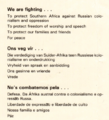Apartheid facts for kids

Apartheid was a system of unfair rules in South Africa. It was in place from 1948 until the early 1990s. This system treated people differently based on their skin color and other features. The word apartheid means "separateness" in the Afrikaans language.
Before apartheid, there was already some separation of races in South Africa. But in 1948, a group called the National Party came to power. They made many new laws that made this separation much stricter. These laws forced different racial groups to live apart and have different rights.
Under apartheid, people were officially divided into four main racial groups. These groups were forced to live separately. Non-White people, especially Black people, lost many basic rights. The system was ended in 1994 when a new set of laws was put in place.
The last president during apartheid was F. W. de Klerk. He worked with Nelson Mandela, a famous political prisoner, to end the system. After they talked, Nelson Mandela was freed from prison. In April 1994, South Africa held its first election where people of all races could vote. Nelson Mandela became the first Black president of South Africa. Both de Klerk and Mandela won the Nobel Peace Prize for their work.
Contents
What Was Apartheid Like?
During apartheid, the government divided people into racial groups by law. This system took away many basic rights from non-White people, especially Black South Africans. For example, White people could go to certain areas, but Black people often needed special passes to travel or work in those places.
The government also forced many Black people to move from their homes. From 1960 to 1983, a plan called the Bantustan Policy made Black South Africans move out of areas set aside for White people. Many other laws were made too. For instance, people of different races could not marry each other. Black people could not own land in White areas or vote in national elections.
The United Nations (UN) did not agree with South Africa's apartheid policies. Many protests happened inside South Africa. Two famous protests were in Sharpeville in 1960 and Soweto in 1976. After the Sharpeville Massacre, the UN tried to remove South Africa from the organization. However, some powerful countries stopped this from happening.
The Soweto Uprising started because Black students were forced to learn some school subjects in Afrikaans. Many Black people did not like Afrikaans because it was the language of the government that supported apartheid.
How Apartheid Ended
In 1989, F. W. de Klerk became the President of South Africa. He wanted to change the unfair system. In 1990, de Klerk announced that the ban on the African National Congress (a political group fighting apartheid) was lifted. He also said that Nelson Mandela would be released from prison.
In 1991, the UN helped create the National Peace Accord. This agreement aimed to stop political violence in South Africa. Twenty-seven groups and governments agreed to it. After this, the Convention for a Democratic South Africa (CODESA) was formed. CODESA worked to find a peaceful way to end apartheid.
The first election where people of all races could vote happened on April 27, 1994. Nelson Mandela was elected President. De Klerk and Thabo Mbeki became his deputies. This date is seen as the official end of apartheid.
Even though Black South Africans gained equal rights by law, there are still big differences in wealth between Black and White people. In 2012, a study found that the average Black family earned much less than the average White family. Nelson Mandela spent most of his life fighting against apartheid. Without his efforts, these important changes might not have happened.
The Goal of Apartheid
The main goal of apartheid was to separate the people of South Africa into small, supposedly independent nations. The areas for Black people were called Bantustans. South Africa claimed these were independent countries and even exchanged ambassadors with them. However, most other countries did not agree.
The National Party government did not want to spend a lot of money on these separate nations. They also wanted to keep most of South Africa's land for White people. This included rich areas like the gold mines of Johannesburg. They wanted Black men to work in these mines for very low wages. But their families had to live far away in the Bantustans or face being put in prison.
Related pages
- Race (sociology)
- Racial segregation
- Convention on the Elimination of All Forms of Racial Discrimination
Images for kids
-
Daniel François Malan, the first prime minister during the apartheid era (1948–1954).
-
Hendrik Verwoerd, a key figure in creating apartheid laws. He was prime minister from 1958–1966.
-
A protest against apartheid at South Africa House in London, 1989.
-
De Klerk and Mandela together in Davos, 1992.
See also
 In Spanish: Apartheid para niños
In Spanish: Apartheid para niños












